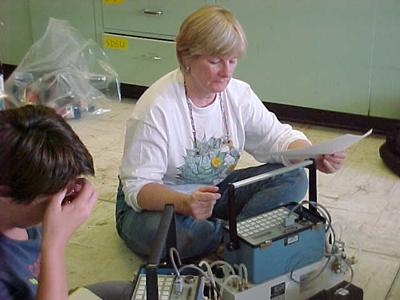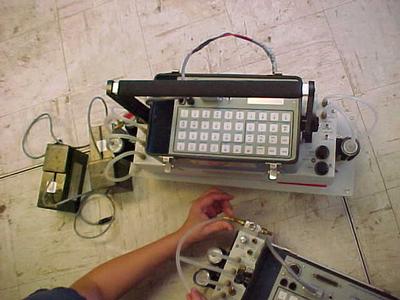10 June, 2001
Sunday
The sun is trying, and succeeding at times, to shine through the clouds and
then we had 5pm snow flurries! Weather changes quickly here. Things are
warming up and the effects are noticeable just overnight. The amount of
visible tundra has increased and the amount of clothes Iím wearing is
decreasing. That inverse relationship will probably be the trend for the next
few weeks. One cannot survive without high rubber boots here. One arcticle of
clothing which stays all winter and all summer are the knee-high rubber boots.
They keep the snow out, the mud out and the water out.
I programmed the LI COR this afternoon. This instrument (pictured below) is a
portable photosynthesis measuring system. When in use we will use it to give
us CO2 flux measurements from the vegetation at the site. Everything we are
doing here revolves around quantifying amounts of CO2 being stored in the
tundra and being released from the tundra. Why so much time and energy spent
on this gas?
As you probably already know there is much concern over the prospect of global
climate change and the effects such a change would have on the earth as a
system. The earth is naturally warmed by the sun's energy; light photons
pass through the atmosphere unimpeded, strike something solid and the energy
is transformed from light energy to heat energy, a longer wavelength of energy.
This heat, being less dense (lighter) then the air around it rises and if it
doesn't get absorbed by any heat trapping gases or reflected back to the
surface by clouds, it will rise and dissipate into the upper atmosphere.
There are naturally occurring gases in our atmosphere that do act to absorb
some of the heat energy and this is beneficial for you, the planet and me.
This trapped heat keeps the planet warm and provides us with a very nice and
comfortable place to live. The gases that make this possible are the
Greenhouse Gases(GHG), which include, CO2 (carbon dioxide), CH4 (methane), O3
(ozone), N2O (nitrous oxide) and H2O vapor. The 6th GHG is (H)CFC
(chlorofluorocarbons), which is a manmade GHG.
This is why scientists like Glen Kiroshita, who I am working with, want to find
out what the arctic is doing with its stored carbon. Historically, up until
about 10 years ago, it was thought that the frozen arctic was a sink (absorber)
of carbon. The plants would take in the CO2 during photosynthesis and then
when winter came the vegetation would freeze, locking the CO2 away in the
frozen ground. In the last several years it has been shown that this is only
a partial picture of what happens. Since the tundra makes up 5% of the land
area of earth what happens here represents a significant amount of CO2 on the
global scale of things.
It was thought that if warming is occurring arctic tundra plants would have a
longer growing season (temperature wise) thus more plants would grow and they,
it turn, would absorb more carbon from the atmosphere. What Walt Oechel the
PI on this project and Glen who works with Walt, have seen is that does occur
initially, for the first 2 or 3 years but temperature is only one of a number
of variables which vegetation depend on to grow. Some of the others
ingredients necessary for growth are H2O, light and sufficient amounts of
specific nutrients, the main one being nitrogen. Tundra soil does not have
much available nitrogen so that becomes a significant limiting factor to plant
growth. After the first 2 or 3 years of increased vegetation production it
was seen that healthy plant growth was slowed. The plant productivity did
reach a balance and returned to what occurred the previous years.
Arctic soils do not break down nutrients as fast as other, more temperate
areas do mainly to the extreme climate. The cold tends to preserve rather
then break down matter here and so nitrogen, though in the soil, is basically
unavailable and limits plant productivity.
Why study CO2?
More CO2 = a warmer earth. If arctic plants are not using more of the
available CO2 we end up in a positive feedback loop and things potentially
keep getting warmer.

I am programing the LI COR before we take it out to the field. Working on the instraments is much easier inside where it is warm and you don't have big heavy gloves on !

Very simple water pumps to keep the plots free of standing water. Right a number of them are 3 inches below water.

Close up view of the portable photosynthesis system we are using to measure CO2 fluv in the field. I is run off a small battery.
Contact the TEA in the field at
.
If you cannot connect through your browser, copy the
TEA's e-mail address in the "To:" line of
your favorite e-mail package.
|
